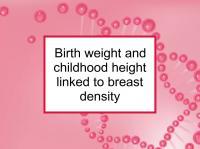High birth weight and tall stature in childhood are known risk factors for breast cancer in adulthood. Now a new study has linked these attributes to increased breast density, also known to be strongly associated with heightened risk of breast cancer. The study also reports that older mothers are more likely to have daughters with dense breasts.
High birth weight and length are associated with increased risk of breast cancer in adulthood. It is possible that birth weight, as a proxy for in utero hormone exposure, could potentially influence breast cancer risk through the long-term effects of sex and growth hormones on breast tissue development.
One study found that women who weighed more than 8.8 lbs at birth had a significantly higher risk of breast cancer than women who weighed less than 5.5 lbs.
Daughters of older mothers also have more dense breast tissue
The new study referenced above found that high birth weight and childhood height are associated with dense breasts, a known risk factor for breast cancer. In addition, the study reports that women whose mothers were over 39 at the birth are more likely to develop dense breasts than women with younger mothers.
The study was conducted to test the theory that variables associated with growth and development influence mammographic density, thereby contributing to breast cancer development.
Study design
The study included 3,574 women from 45 to 68 years old who participated in breast cancer screening programs in seven Spanish cities. A single radiologist made blind, anonymous measurements of mammographic density. A questionnaire was used to obtain early life data. The analysis was performed according to menopausal status and adjusted for age, number of children, body mass index (BMI), and other childhood variables.
Study results
A total of 811 (23%) of the women had mammographic density of over 50%; 5% exceeded 75%. High mammographic density was associated with low prepubertal weight, tall height before puberty, and having mother aged at least 39 at birth. On the other hand, lower percent high mammographic density was found among women with higher prepubertal weight, low birth weight and earlier first period.
The authors conclude that these early-life factors may influence breast density through elevated exposure to hormones and growth factors during the development of the breast gland.
Please see our articles on breast density and how to protect our daughters from breast cancer for more information.
